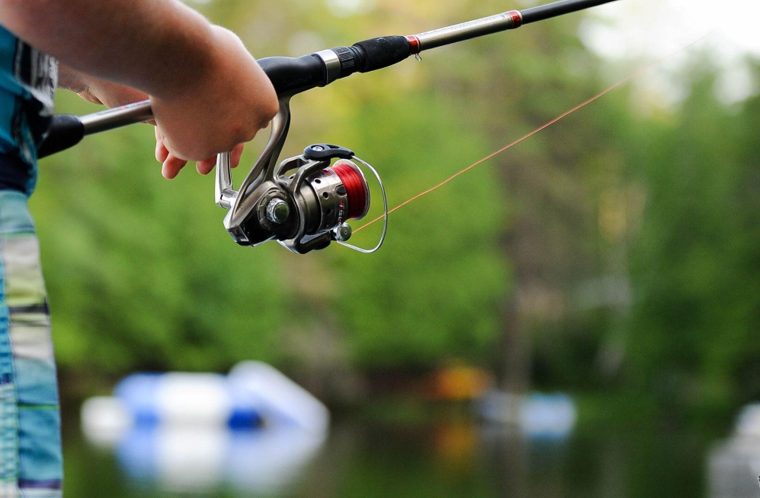Anglers welcome the first warm days of spring as an opportunity to leave work early and spend some extra time outside.
As water temperatures warm, bass will begin moving shallower and becoming more active. Jig and trailer combinations, spinner baits, lipless crank baits which imitate an unsuspecting or busy baitfish are among some of the best lures for early spring bass fishing.
Table of Contents
Water Temperature
Now that the winter thaw is complete, bass are starting to make their transition from deeper water winter haunts into shallower areas for breeding. Water temperature plays a vital role in this phase of their lives as they transition.
Water temperatures between 50 and 55 degrees Fahrenheit will see bass feeding heavily as they migrate towards their spawning grounds. They’re actively searching for baitfish as they move into shallower waters, congregating around cover such as docks, piers, logs, brush piles, grass beds or hydrilla beds – areas which may also offer opportunities for schooling bass to travel together.
As soon as the water temperature reaches around 60 degrees, bass will enter their pre-spawn stage and begin considering mating. At this stage they begin searching for shallow cover such as grass beds, hydrilla or lily pads to hide under, becoming very territorial as they strike quickly at any lure or bait presented to them.
As soon as the water temperature reaches 70 degrees, bass will enter spawning mode with great aggression and begin protecting their beds and eggs from bluegills. Once they find good locations to make their beds they become very protective over them – usually until their spawn is complete. This stage usually lasts several weeks before moving on.
Temperature plays a large role in the spawning process. This means that any unexpected temperature drops could affect your day of fishing. People looking to make the most of spring fishing should have bass fishing strategies for handling cold fronts ready just in case of inclement weather. If you see any storms, however, you should stay on land until conditions are safe.
Water Clarity
Although spring weather can be unpredictable, most bass anglers look forward to experiencing their first warm days of the year on the water chasing trophy largemouths – an activity they find very fulfilling and early spring offers some of the greatest opportunities.
Water clarity can greatly influence bass behavior and location. Clearer waters tend to mean closer-to-surface bass that are easier to spot as they ambush prey and crawfish; in contrast, murkier conditions could mean they are hiding in deeper water, necessitating deeper presentations for success in catching them.
Water clarity can also be affected by the amount of nutrients and sediment present in a lake or reservoir, which can gradually cause it to become murkier over time. Dirty waters also interfere with bass’s nesting activity as they require clean waters for incubating their eggs before hatching them out.
As soon as the water begins to warm up, start looking for staging areas such as creek channels and ledges, rocky points or shallow weed beds in natural lakes and ponds as potential staging locations. You can click here for more tips on how to find good areas to fish for bass.
Pre-Spawning Areas
Bass move to shallow spawning areas as the temperatures begin to increase in spring, feeding heavily during their pre-spawn period in order to regain lost weight and prepare themselves for egg laying.
Spawn sites vary significantly between lakes; prime locations tend to include rocky riprap, bridge abutments, culverts and underwater islands as well as deep brush piles with submerged points for laying eggs as well as shallow bays with heavy cover or newly emerging weed beds that provide cover from winds.
Anglers typically target the north shorelines of lakes and rivers due to strong southern breezes warming these spots first, although other hotspots include creek mouths, coves, and bluffs. At the beginning of pre-spawn, anglers should concentrate their efforts on deeper flat shoals or pockets found at the back of creeks.
There is an assortment of bass-catching lures available for use in staging areas. Bass anglers often utilize spinner baits in early spring due to the vibrations they produce that can be felt by fish as well as creating noise. Jig and trailer combinations, square-billed lipless crank baits, suspending jerk baits are also excellent lure options available in these situations.
Bass anglers fishing from staging areas should take note of both water temperature and color before choosing their baits. When fishing clear water, brightly-colored bait may work more effectively due to being seen by bass more clearly whereas darker-colored water allows them to see potential prey like shad more clearly than brightly colored waters do.
Post-Spawning Areas
To help locate post-spawn fish, watch for when shad begin migrating deeper waters and when their movement starts changing direction. Bass will follow these signs into deeper areas – either deep humps or points leading into creeks, embankments or pockets of water.
After several weeks, bass will begin to move away from these shallow areas and return to their regular feeding patterns, particularly as more shad enter shallow waters – providing easier meals for bass who no longer have fry to protect.
Anglers know this means targeting areas with cover such as brush piles, docks, weed lines or contour breaks as great places for fishing. Working the cover slowly and steadily allows anglers to feel for strikes while placing their lure into an effective strike zone where bass can see it.
Being familiar with the habits of bass can help fishers prepare to catch them. Spring is a great time to get outdoors and enjoy this popular sport.
